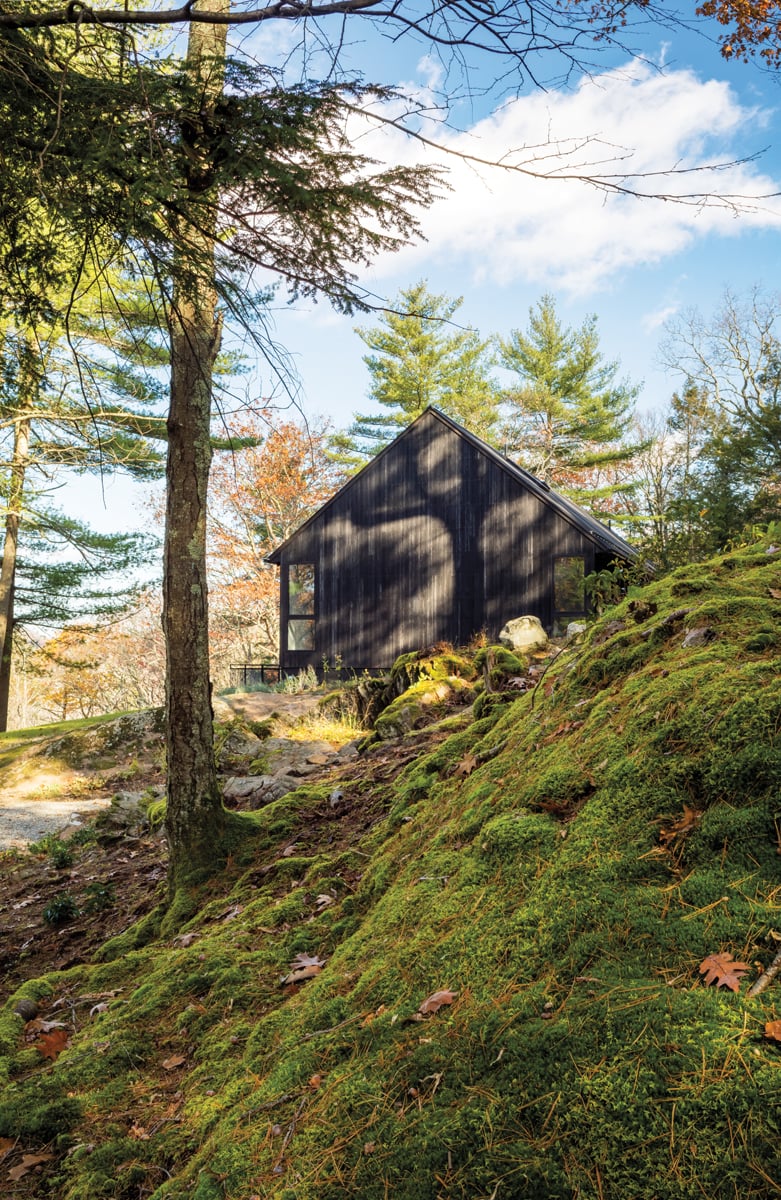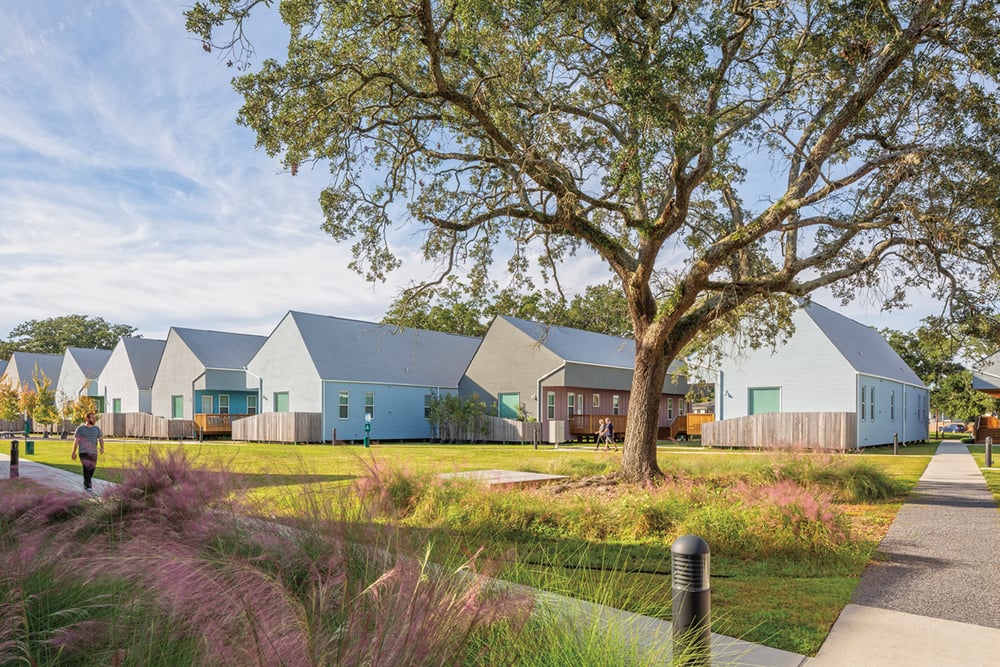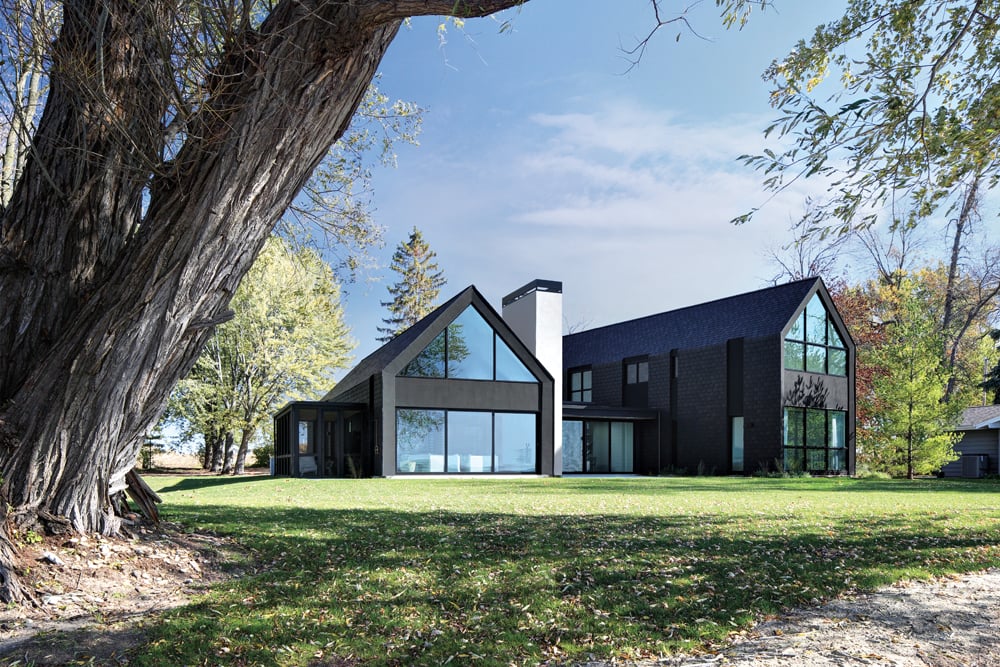
June 8, 2021
Gabled Roofs Experience a Revival Across North America
Architects explore the patriotism associated with pitched roofs and share how they’re reimagining this staple of suburban house styles.

Gabled roofs are as potent a symbol of Americanness as apple pie: The roof typology and dessert are European, yet both are viewed as emblematic of a national domesticity. So it’s meaningful that gabled roofs are experiencing a revival across North America in new variations and materials at a time when clients and communities tend to weigh each project’s social and environmental impact. After years of being viewed (and taught) as a feature at odds with Modern architecture, there seems to be a gable 2.0 emerging.
“‘Contextual’ doesn’t have to be over-the-top traditional. It can completely fit in while still being innovative,” says Katherine Chia, principal of New York– based firm Desai Chia Architecture with Arjun Desai. Indeed. And while three examples of that innovation would usually suggest a trend; dozens viewed over the past few years signal an evolution—or at least that there’s an encouraging number of firms that have jettisoned binary thinking when it comes to American house styles. A middle ground is cropping up.
In Wisconsin, the Woven House by Bruns Architecture, for instance, “distills the shape down to a typical child’s drawing of home, by overstating the gable and erasing the overhang,” says principal Stephen Bruns. Doing so gets rid of canned decoration that might otherwise make it a “caricature.” One continuous slatelooking material clads the structure from the roof ’s peak to the graded ground— actually a composite made from recycled tires that functions as a rainscreen instead of a conventional eaves trough.
The Nova Scotia–based studio MacKay-Lyons Sweetapple Architects has designed several houses in Canada that feature the form but modernize it with roofs and walls clad in expanses of weathering Cor-Ten steel. “I’m interested in the vernacular wherever I find it,” says principal Brian MacKay-Lyons. “Repeating the ‘good generic’ is how you make a village.”

For a weekend house in Connecticut, Desai Chia recast the regional gabled barn typology in Japanese-style charred Kebony yellow pine wood siding known as shou sugi ban. Because they chose the gabled roof over something edgier—such as the undulating butterfly-shaped roofline they used on a different project, Michigan Lake House—the firm went to great lengths to find technology that could help reveal the form on the interior. Specially engineered framing by David Kufferman PE Structural Engineers allowed conditions that expose the steep vault created by the sloped roof, unobstructed by the usual trusses and beams. “It’s not like we want to be known as the pitched-roof architects,” says Chia of the extra effort needed to deploy the type here. In this case, she says, “it was relevant to being contextual.”
Jonathan Tate, founder and principal of his eponymous firm OJT (Office of Jonathan Tate), has taken context to the next level by creating a unique local design language in New Orleans with his distinctive rooflines. His housing, slightly tweaked for each site, mirrors the scale and rhythm of surrounding neighborhoods because, as he says, “I get a particular delight out of addressing a formal typology, a context in which I grew up. It feels familiar and nice to engage it, but also to find ways we can subvert it.”
“Radically different but familiar” is how Jennifer Bonner, founder of MALL and associate professor of architecture at Harvard Graduate School of Design, describes her own Atlanta residence, Haus Gables, which she designed as a life-size study of asymmetrical gabled roofs built of cross-laminated timber, which also allows interior views unimpeded by support beams and posts. “You’re observing the new materiality. The conventional expressions and materials have changed, but it’s still a gabled typology,” Bonner says.
Many instances of the new gabled roofs generation share a lack of conventional gutters: “Without overhangs, we collect water around the base of the house into a gravel basin with piping below grade,” Bruns explains. “Eliminating the gutter and letting the water run down the sides of the house is an innovative way to manage this water.” Interior access and a glorification of the gabled space indoors are also common features. “The problem with conventional gabled roofs is that you never get to live in them, unless you explore the attic and play,” Bonner says.

Putting the form and its cultural currency in service of people who’ve historically lacked access to it also drives explorations of affordable versions, which can further delight. Take, for example, the Bastion Community, OJT’s recently completed affordable housing development for veterans in New Orleans’s Gentilly neighborhood. Its aerial view echoes that of idyllic 1950s and ’60s–era suburbs such as Levittown, New York, where charming peaked rooflines also carried restrictive racial covenants that forbade sales to nonwhites. While marketed as a symbol of homeownership for the masses, those iconic suburban rooflines came to be associated with redlining for the marginalized. A resemblance to those once-restrictive suburbs is a characteristic of Tate’s project that makes it seem almost like a reclamation of the housing type—even if that wasn’t what he intended. “The objectives were to develop a massing and spatial organization that supported the mission and integrated into the surrounding neighborhood,” he says.
In areas of Alabama, Nebraska, and Wyoming, and in Wisconsin, where Bruns Architecture is based, some developers still rely on restrictive covenants, though no longer to impose racial exclusivity, only architectural homogeneity. “Frank Lloyd Wright’s house wouldn’t have been acceptable in these developments,” says Stephen Bruns. One of his clients who’d been searching for a parcel to build on pored over 124 pages of legalese to discover that the developers selling the lot hadn’t just added a pitched roof covenant, but even specified the degree of the slope. “A uniformity has been happening because of these covenants, and one person’s decision is being conditionally prescribed,” Bruns says.
Viewed through that lens, developers and their Architectural Control Committees and homeowners associations could be undermining efforts to update and improve gables in the same way the Trump administration’s proposed order to limit federal architectural styles could have killed innovation in public buildings.
From the growing body of hybridized, new-familiar-contextual projects, there are enough innovators looking to adapt earlier forms—not just enshrine them in new construction—to bring about real change. “We’re trying to start a dialogue with our surroundings, not have our own conversation,” Tate says.
You may also enjoy “Berlin’s Architectural Transition to Postmodernism Gets an Overdue Examination”
Would you like to comment on this article? Send your thoughts to: [email protected]
Register here for Metropolis’s Think Tank Thursdays and hear what leading firms across North America are thinking and working on today.














